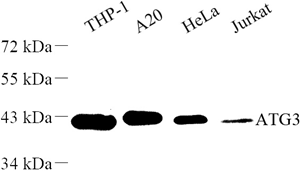| Reactivity: | H,M |
| Applications: | WB |
| Host Species: | Rabbit |
| Clonality: | Polyclonal |
| Full Name: | ATG3 rabbit polyclonal antibody |
Gene Name: | Ubiquitin-like-conjugating enzyme ATG3 |
Synonyms: | Autophagy-related protein 3, Protein PC3-96, APG3-like, hApg3, ATG3, APG3, APG3L |
Immunogen: | Recombinant protein corresponding to Human ATG3 |
Isotype: | IgG |
Purity: | Affinity purification |
Predicted MW. | 36 kDa |
Observed MW. | 40 kDa |
Uniprot ID: | Q9NT62, Q9CPX6 |
Product Usage Information
Applications | Species | Dilution | Positive tissue |
WB | Human, Mouse | 1: 500-1: 1000 | THP-2, A20, HeLa, Jurkat |
Background
Macroautophagy is the major inducible pathway for the general turnover of cytoplasmic constituents in eukaryotic cells, it is also responsible for the degradation of active cytoplasmic enzymes and organelles during nutrient starvation. Macroautophagy involves the formation of double-membrane bound autophagosomes which enclose the cytoplasmic constituent targeted for degradation in a membrane bound structure, which then fuse with the lysosome (or vacuole) releasing a single-membrane bound autophagic bodies which are then degraded within the lysosome (or vacuole). APG3L is an E2-like conjugating enzyme facilitating covalent binding of APG8 (MAP1LC3) to phosphatidylethanolamine (PE). APG7 (an E1-like enzyme) facilitates this reaction by forming an E1-E2 complex with APG3. Formation of the PE conjugate is essential for autophagy.
Images
|
|
Western blot analysis of ATG3 (GB111131) at dilution of 1: 500 |
Storage
| Storage | Store at -20°C for one year. Avoid repeated freeze/ thaw cycles. |
| Storage Buffer | PBS with 0.02% sodium azide, 100 μg/ml BSA and 50% glycerol. |

